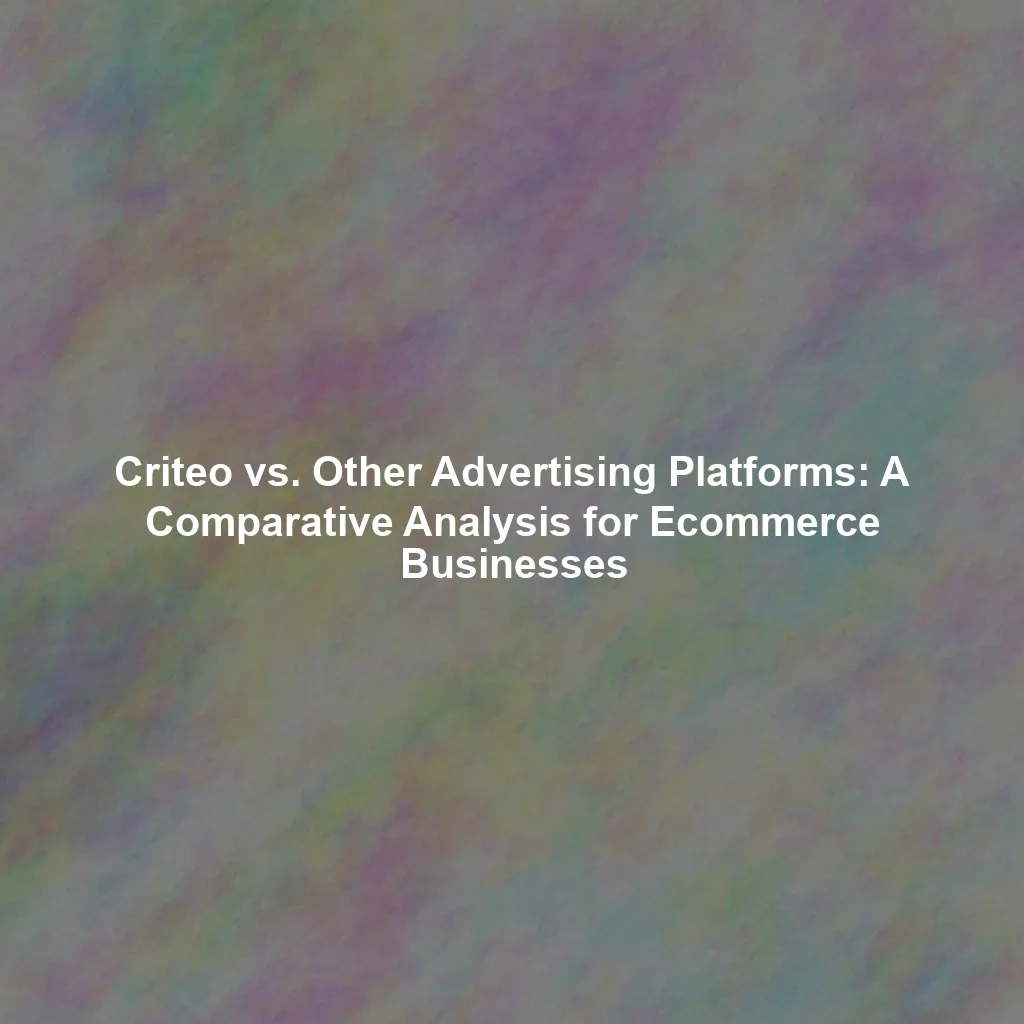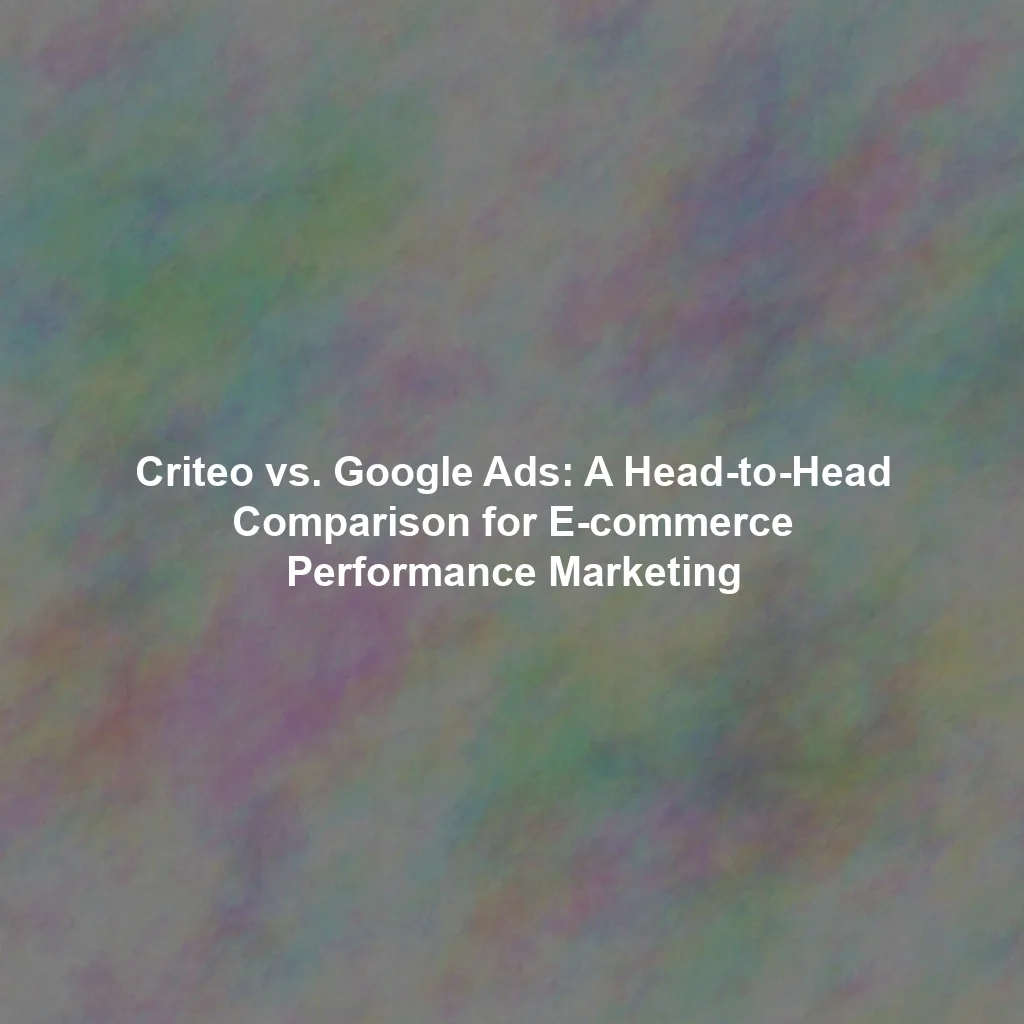In the dynamic world of ecommerce, selecting the right advertising platform is crucial for driving sales and achieving sustainable growth. While multiple options exist, Criteo, Google Ads, and Facebook Ads consistently stand out as powerful contenders. This article provides a comprehensive comparative analysis of these three platforms, examining their strengths and weaknesses across key aspects like cost, reach, targeting capabilities, and reporting. Our aim is to equip ecommerce businesses with the data-driven insights needed to make informed decisions and optimize their advertising strategies.
Understanding the Advertising Landscape
Before diving into the specifics, it’s important to understand the unique value proposition of each platform:
- Criteo: Specializes in personalized retargeting ads, dynamically displaying products previously viewed by users across a vast network of publishers.
- Google Ads: Offers a wide range of advertising options, including search ads, display ads, and shopping ads, allowing businesses to target users based on keywords, interests, and demographics.
- Facebook Ads: Leverages Facebook and Instagram’s extensive user data to deliver highly targeted ads based on demographics, interests, behaviors, and custom audiences.
Cost Analysis: Finding the Right Balance
Criteo Cost Structure
Criteo typically operates on a Cost-Per-Click (CPC) or Cost-Per-Mille (CPM) model. Costs can vary based on industry, competition, and the quality of your product feed. While Criteo can be effective for retargeting, it’s essential to monitor performance closely and optimize bids to ensure a positive return on ad spend (ROAS).
Google Ads Cost Structure
Google Ads offers a flexible bidding system, including CPC, CPM, and Cost-Per-Acquisition (CPA) options. Search ads tend to be more expensive than display ads, and competition for popular keywords can drive up costs significantly. Effective keyword research and campaign management are crucial for maximizing your budget.
Facebook Ads Cost Structure
Facebook Ads uses a similar bidding system to Google Ads, with CPC, CPM, and optimization for conversions. Costs can vary depending on your target audience, ad placement, and ad quality. Facebook’s granular targeting options allow you to reach specific segments, but it’s important to test different audiences and ad creatives to find what performs best.
Reach and Audience: Casting a Wide Net
Criteo’s Retargeting Reach
Criteo’s strength lies in its extensive network of publishers, enabling you to reach users across a wide range of websites and apps. However, its reach is primarily limited to users who have already visited your website or shown interest in your products.
Google Ads’ Broad Reach
Google Ads offers unparalleled reach through its search and display networks. Search ads allow you to capture users actively searching for your products, while display ads can reach a broader audience based on their interests and browsing behavior. YouTube advertising further expands Google’s reach.
Facebook Ads’ Targeted Reach
Facebook Ads excels at reaching highly specific audiences based on demographic, interest, and behavioral data. This allows you to target users who are most likely to be interested in your products, but it’s essential to carefully define your target audience to avoid wasting ad spend.
Targeting Capabilities: Precision Marketing
Criteo’s Personalized Retargeting
Criteo’s core strength is its ability to deliver personalized retargeting ads based on users’ browsing history on your website. It dynamically displays products that users have previously viewed, increasing the likelihood of conversion.
Google Ads’ Versatile Targeting
Google Ads offers a wide range of targeting options, including:
- Keyword Targeting: Reach users searching for specific terms.
- Demographic Targeting: Target users based on age, gender, and location.
- Interest Targeting: Reach users interested in specific topics.
- Remarketing: Retarget users who have previously interacted with your website.
Facebook Ads’ Granular Targeting
Facebook Ads offers the most granular targeting options, allowing you to reach users based on:
- Demographics: Age, gender, location, education, etc.
- Interests: Hobbies, interests, and pages they like.
- Behaviors: Purchase history, device usage, and online activity.
- Custom Audiences: Upload your own customer data to target existing customers or create lookalike audiences.
Reporting and Analytics: Measuring Success
Criteo’s Performance Metrics
Criteo provides detailed reports on key metrics such as impressions, clicks, conversions, and ROAS. You can track the performance of your retargeting campaigns and optimize your bids accordingly.
Google Ads’ Comprehensive Reporting
Google Ads offers a comprehensive suite of reporting tools, allowing you to track the performance of your campaigns across search, display, and shopping. You can analyze keyword performance, ad performance, and conversion data to identify areas for improvement.
Facebook Ads’ In-Depth Analytics
Facebook Ads provides in-depth analytics on ad performance, audience engagement, and conversion rates. You can track the performance of your ads across different devices and placements, and use A/B testing to optimize your ad creatives and targeting.
Data-Driven Insights and Recommendations
So, which platform is right for your ecommerce business? Here’s a summary to help you decide:
- Choose Criteo if: You want to focus on personalized retargeting to re-engage website visitors and drive conversions.
- Choose Google Ads if: You want to reach a broad audience and capture users actively searching for your products.
- Choose Facebook Ads if: You want to target highly specific audiences based on demographic, interest, and behavioral data.
Ideally, a multi-platform approach, combining the strengths of each platform, is the most effective strategy. For instance, use Google Ads for initial customer acquisition, Facebook Ads for targeted brand awareness, and Criteo for retargeting those who have shown purchase intent.
Conclusion
Selecting the right advertising platform is a critical decision for ecommerce businesses. By carefully evaluating the cost, reach, targeting capabilities, and reporting features of Criteo, Google Ads, and Facebook Ads, you can develop a data-driven strategy that aligns with your specific needs and objectives. Remember to continuously monitor performance, optimize your campaigns, and adapt your approach as the ecommerce landscape evolves. A strategic blend of these platforms often yields the best results, driving sustainable growth and maximizing your return on investment.
 Skip to content
Skip to content

